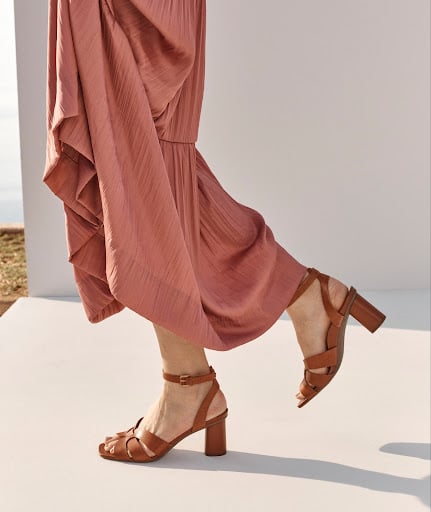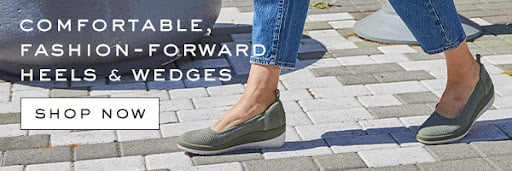If you think back to your childhood, the main characters in some of your favorite stories and movies likely wore extravagant heels. Whether it was in the 1940s or an indiscriminate time period in Disney animation, these types of heeled shoes were the statement piece of the ensemble. Cinderella had her beautiful glass slippers, while Dorothy wore a glimmering pair of ruby-red heels—just to name a few examples.
As an adult, you might look back and wonder how Cinderella wore those glass slippers all evening. They were probably pinching her toes and giving her blisters. Thank goodness she had a midnight curfew so she could finally take them off!
Regardless of how you feel about heels now, considering the popularity of heels in stories and movies like these begs the question, and why were high heels invented and where did they originate? Strap on your shoes and join us for a walk down memory lane as we discuss the history of high heels .
Chapter One: These Boots Were Not Made for Walking (10th Century CE)
Our first stop on the High Heels History Tour begins in the 10th Century CE (a.k.a. the 900s) in Persia, 1 (present-day Iran). Because of modern-day preconceptions, you might assume a woman donned the first pair of heels—and that would be incorrect!
When we look back on the complete history of shoes, we find that it was actually men who rocked the first high heels (although they would likely be the first to tell you that they were doing so not out of fashion, but out of necessity).
The Persian army featured a large number of men on horseback. But shooting a bow while on the back of a galloping horse was no easy feat. To help the Persian Cavalrymen remain in the stirrups more easily, they created shoes with heels. These heeled shoes helped to steady soldiers on their horses so they could successfully fire their arrows at a breakneck speed.
Fast forward to present day, and consider the ensemble of a modern-day cowboy. While we wouldn’t consider the standard cowboy boot to be high heels, they do have a prominent heel on the back that comes in handy when riding horses. In this case, the old saying rings true—if it ain’t broke, don’t fix it. While they may not necessarily have made a fashion statement back then, these heeled boots served a practical purpose and went on to be used throughout history.
Chapter Two: Girls—and Boys—Just Wanna Have Fun (14th Century)
Around the 14th century, the high heel trend made its way to Europe through trade with the Persians. 1 But instead of using them the way the Persians had, Europeans took the original blueprint and created their own high-heel design called chopines. 2
A chopine vaguely resembles a pair of wedges in that they have a high platform that makes you appear taller. When they first came out, many men and women would wear these platform shoe styles in the name of practicality. A pair of stilt-like chopines could help keep feet and the bottom hem of clothes dry from muddy ground.
Eventually, the platform shoe trend expanded past necessity and entered the realm of fashion statements. Noblewomen and courtesans alike opted for higher and higher pairs of chopines, sometimes reaching up to 20 inches! 2 Of course, at that point, they would require the assistance of a cane or maid to walk from place to place, but everyone knew the heel height meant the wearer was well-to-do.
Chapter Three: Red High Heels (17th Century)
A few hundred years later, high heels had transformed yet again. During the 16th and 17th century, they more closely resembled the high heeled shoe designs we might wear today:
- The toes of the shoe were low to the ground and completely covered by fabric like satin or velvet
- The heel was raised by a small block (think: block heel, but extremely vintage).
It was around this time that King Louis XIV of France began his fascination with high-heeled shoes. He took what was a trendy accessory to an otherwise normal ensemble and turned it into a must-have item for all the men of France, serving as a staple in men’s fashion.
In fact, King Louis XIV loved heels so much that he began having specialty pairs made for himself that were dyed or painted red. (All the better to notice you in your radiant red high heels, my dear.)
Since the king was so fond of high heels, princes, kings, and noblemen of the court also began adding heels to their wardrobes to show off their high standing in society. To wear a pair of heels during the 17th century meant that a man carried the following coveted characteristics:
- Status
- Wealth
- The favor of the king
Chapter Four: If the Shoe Fits (Early 18th Century)
Of course, it didn’t take long for the high-heel trend to trickle down to the common folk in Europe. Men and women began incorporating their own sets of heels in their everyday wear. As it became more common for both sexes to wear them, it was decided that there should be some distinction between men’s and women’s heels.
So, the heels of women’s shoes started to become thinner ( hello, precursor to the stiletto heels), and the shoes themselves began to exude more feminine characteristics.
Around the Age of Enlightenment, men began to toss around the theories of “reason” and “skepticism”. It was with these thoughts in mind they decided high heels were an irrational and unnecessary style of footwear for men. And just like that, men stopped wearing heeled shoes in favor of more “sensible” flat footwear.
Chapter Five: Heads Will Roll (Late 18th Century)
Every fashion trend eventually ends, and high-heeled footwear was no exception. They began to ebb in popularity around the time of the French Revolution. They were synonymous with wealth and class during a time when almost no one wanted to be associated with royalty (quite possibly for fear of losing their heads like many of the aristocrats and revolutionaries). 3
Meanwhile, in the Americas, high heels were also facing a losing battle in popularity during the 18th century—but for an entirely different reason. At the time, high heels were seen as promiscuous and a mark of the devil, so they quickly fell out of fashion for women who feared being persecuted for wearing them. 4
Chapter Six: Boogie Woogie Bugle Boy (Early and Mid-20th Century)
During the first half of the 1900s, civilization was facing more serious matters than choosing new high-heel trends. With World War One wrapping up and World War Two nipping close on its heels (pun intended), some of the common materials used to make heels were no longer available.
However, that didn’t completely stop the demand for them. So, manufacturers instead started using more readily available items to create heels, like:
- Cork
- Wood
During the 1950s, influential figures like Marilyn Monroe began embracing the idea of wearing high heels to accentuate their figures and exude sexuality. With Marilyn on board, many women in America quickly followed suit.
Chapter Seven: Diamonds on the Soles of Her Shoes (Late 20th Century)
From the 1980s to the start of the new millennium, high heels as we know them finally made their fabulous grand entrance. Thanks to fashion magazines (and Sex and the City) , the world saw some very chic high-heel moments throughout the decades:
- The 1980s – Rock stars of the 80s like Madonna, Freddy Mercury, and David Bowie brought the heat to high-heel mania by rocking neon colors, embellished heels, and thick-heeled pumps.
- The 1990s – While the Spice Girls brought platform shoes to the limelight (and we’re forever grateful), the real MVP of high-end high-heel fashion in the 90s was none other than Sex and the City’s Carrie Bradshaw. From her love of Manolo Blahniks to her famed saying, “Hello lover,” when speaking wistfully to a pair of Christian Louboutin heeled sandals through a display window, she made high heels of all shapes and sizes a household must-have.
- The 2000s – From sandals with short heels aptly titled “kitten heels” to high-rise see-through heels with clear plastic straps, Y2K brought a whole new slew of high-heeled shoe trends with it.
Chapter Eight: Flawless (Present Day)
Here, we finally reach the last stop of our journey—the present day, where over a thousand years have passed since the Persian Cavalrymen first introduced high heel shoes to the world. And since that time, shoemakers have worked tirelessly to design heels that complement the creativity of today’s fashion trends.
Like most styles that come and go, many of today’s high-heel trends are a combination of blasts from the past mixed with contemporary flair, like Vionic’s new-age Petaluma Slingback Heel or timeless Merlot Heeled Sandal.
And, thanks to recent footwear advancements, you no longer have to wear high heel shoes that are stiff and uncomfortable. From extra shoe cushioning to designs that comfortably hug and support your arches, today’s high heel shoes allow you to look on trend all day long without wondering when you can finally take off your shoes.
Make History in a Pair of Heels From Vionic
In years past, several high heel styles haven’t always been the most comfortable shoe choice, but they’ve always been an excellent option for bringing attention to the wearer and showcasing their sense of style.
With Vionic, you can wear showstopping high heels sure to garner second glances while still feeling supported throughout the day. From heeled sandals like our Zinfandel Block Heel Sandal to classic boho wedges like our Marina Wedge Sandal, we provide heels that offer advanced comfort features, like deep heel cups and enhanced forefoot contours.
No matter the occasion, doll yourself up and make history in a classy yet comfortable pair of high heels from Vionic.
Sources:
- “The History of High Heels.” Love Happens Mag. https://www.lovehappensmag.com/blog/2021/02/02/the-history-of-high-heels/
- “Chopines.” The Met. https://www.metmuseum.org/art/collection/search/82448
- “The Guillotine & the French Revolution.” Students of History. https://www.studentsofhistory.com/the-guillotine-during-the-french-revolution
- Estrada, Kyberlie. “Pains of an Addict. History of Stilettos.” Daily Titan. 28 November, 2012. https://dailytitan.com/lifestyle/pains-of-an-addict-history-of-stilletos/article_0aca40e9-9444-5c7a-ba16-111c19ddc944.html



Leave a Reply